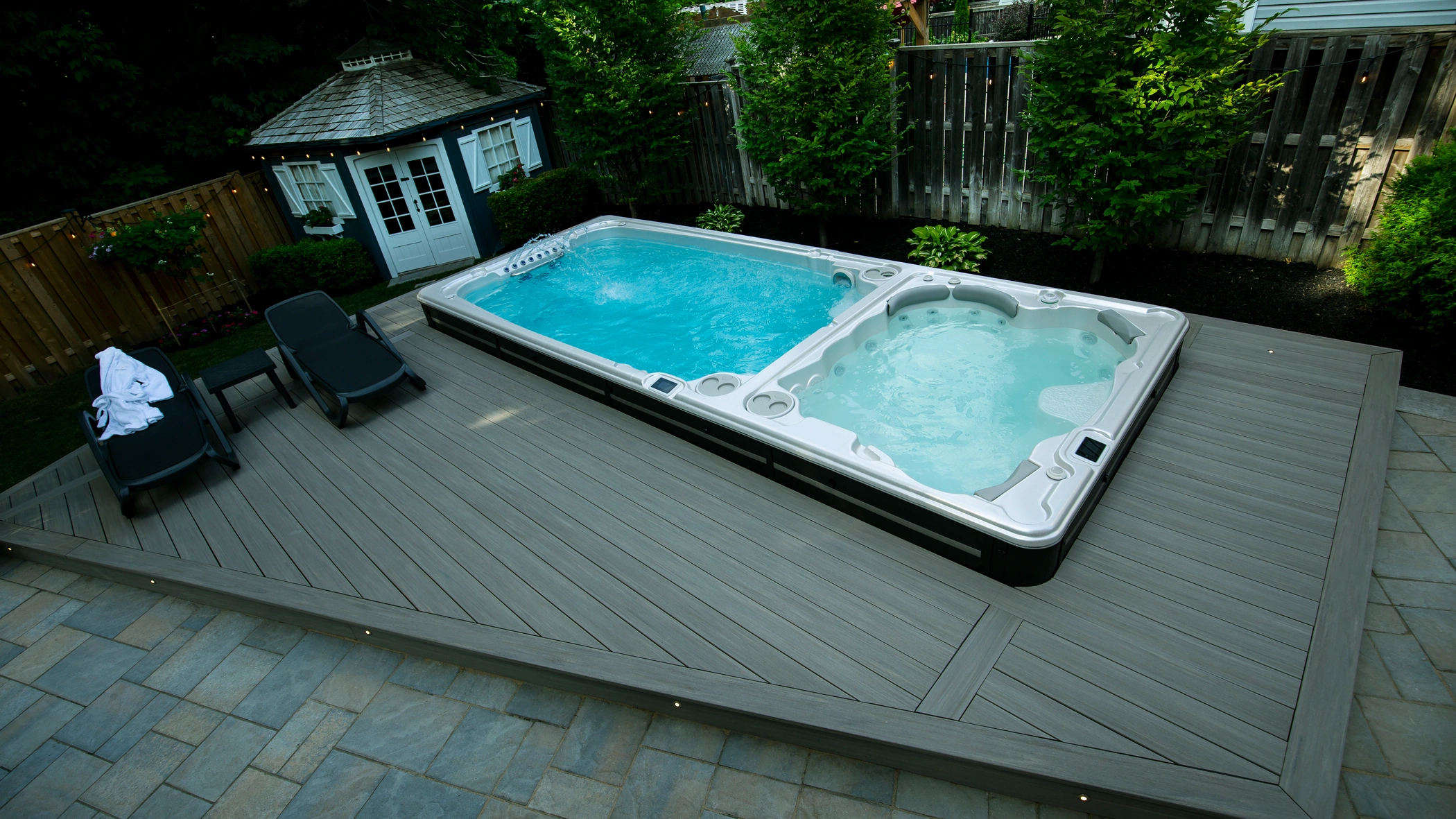Is a Swim Spa Cheaper Than a Pool?

When considering an aquatic addition to your home, one of the most important questions you may ask is: “Is a swim spa cheaper than a pool?” While both options offer great ways to enjoy water activities and fitness in your own backyard, the costs associated with each can vary significantly. At Hydropool, we understand that making this decision requires careful consideration of not just the initial purchase price but also the ongoing costs of installation, maintenance, and operation.
In this article, we’ll break down the costs of both swim spas and traditional pools to help you make an informed decision. From installation to long-term maintenance, we’ll give you the full picture so you can choose the best option for your lifestyle and budget.
Here’s what we’ll cover:
- Initial Costs of Swim Spas vs Pools
- Ongoing Maintenance Costs
- Energy and Operational Costs
- Additional Benefits of Swim Spas
- Which Option Is Right for You?
Initial Costs of Swim Spas vs Pools
One of the most significant factors when deciding between a swim spa and a pool is the initial investment. The price of a swim spa or a pool can vary greatly depending on size, features, and brand. Here’s a general breakdown of what you can expect:
1. Swim Spa Initial Costs
Swim spas are typically less expensive to purchase and install than pools. The price of a Hydropool Swim Spa can range from around $20,000 to $40,000 USD, depending on the model, size, and features. Swim spas are generally easier and quicker to install because they don’t require the same level of excavation or construction as a traditional pool. This makes them a great option for homeowners who want to avoid lengthy installation processes and additional costs like landscaping and permits.
2. Pool Initial Costs
The cost of a traditional pool can vary widely depending on the type (inground or above-ground), size, materials, and features. For a basic inground pool, you might expect to pay anywhere from $30,000 to $70,000 USD. Pools with advanced features like custom landscaping, waterfalls, and automatic covers can push the price well beyond $100,000 USD. Installation of a pool also involves significant excavation and construction, which can further increase the price.
Ongoing Maintenance Costs
While the initial cost of a pool is typically higher than that of a swim spa, it’s important to consider the ongoing maintenance costs. Both swim spas and pools require regular upkeep, but the associated costs can differ.
1. Swim Spa Maintenance Costs
Maintaining a swim spa is generally less expensive than maintaining a pool due to the smaller size and fewer components that need attention. On average, the annual maintenance costs for a swim spa can range from $300 to $800 USD. This includes water care chemicals, filter cleaning, and occasional servicing. With Hydropool’s Self-Cleaning Swim Spas, the frequency and cost of maintenance is reduced, making them an even more cost-effective option in the long run.
2. Pool Maintenance Costs
Pools require much more upkeep due to their larger size and the complexity of their systems. On average, pool maintenance can cost $1,200 to $2,500 USD per year. This includes chemicals, cleaning, and servicing of pumps, heaters, and other pool equipment. Pools also require frequent water balancing and cleaning to keep the water sparkling clean and free from debris.
Energy and Operational Costs
Both swim spas and pools require energy to operate, but the energy consumption of a swim spa is significantly lower than that of a traditional pool.
1. Swim Spa Energy Costs
Swim spas are designed to be more energy-efficient, using less power to maintain the water temperature and operate the jets. On average, you can expect to pay $20 to $50 per month to run a swim spa, depending on factors such as the model, usage, and local energy prices. Hydropool swim spas are known for their energy-efficient design, which helps to reduce the operational costs compared to traditional pools.
2. Pool Energy Costs
Pools, on the other hand, require a lot more energy to run due to their larger size and more complex systems. Heating, filtration, and maintaining the pool’s water temperature can result in higher energy bills. You can expect to pay anywhere from $100 to $300 per month to operate a pool, depending on its size, location, and energy prices. This makes pools significantly more expensive to operate on a monthly basis.
Additional Benefits of Swim Spas
In addition to being more cost-effective, swim spas offer several unique benefits that make them an attractive alternative to pools. Some of these benefits include:
- Year-Round Use: Swim spas can be used year-round, even in colder climates, because they are heated. This allows for consistent use, unlike outdoor pools that are limited to warmer months.
- Compact Size: Swim spas are a great option for homeowners with limited space. They offer the benefits of a pool without taking up the large amount of space required by a traditional pool.
- Dual Use: Swim spas can be used for both relaxation and exercise. You can swim against powerful jets or use the spa for a relaxing soak after a workout, making it a versatile addition to your home.
- Easy Installation: Swim spas can be installed much more quickly and easily than pools, requiring minimal construction and excavation. This means you can start enjoying your swim spa in a shorter amount of time.
Which Option Is Right for You?
When deciding whether a swim spa or a pool is the better option, it ultimately comes down to your personal preferences and needs. Here are a few key considerations:
- Budget: If you're looking for a more affordable option, a swim spa is likely the better choice. The initial cost, ongoing maintenance, and energy consumption are all lower for swim spas than for pools.
- Space: If you have limited space in your backyard, a swim spa is a great solution. Its compact size makes it suitable for smaller areas, while still offering all the benefits of a pool.
- Usage: If you’re looking for a swim spa for exercise and fitness, it’s the ideal choice. Swim spas are designed for swimming, aquatherapy, and fitness activities, whereas pools are primarily for recreation.
- Long-Term Investment: While pools offer a more traditional swimming experience, swim spas provide versatility, year-round use, and lower long-term operational costs.
Is a Swim Spa Cheaper Than a Pool?
In terms of both initial investment and long-term maintenance, swim spas are generally the more affordable option compared to traditional pools. With lower installation, maintenance, and energy costs, swim spas offer an excellent balance of affordability and functionality, making them an ideal choice for those seeking a convenient and versatile aquatic experience.
Still have questions? Reach out to your local Hydropool retailer here.






